
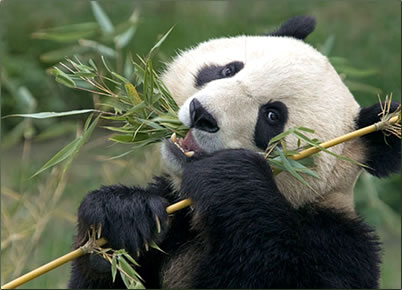
A pandas’ diet consists almost entirely of bamboo stalks, shoots and roots. Munching up to 14 hours a day, they eat from 25 to 40 pounds. Team Husar/Pandas International

By Lucy Corne
As my overflowing dustpan began to sag under the weight of its contents, I stopped to think what an odd way I’d chosen to spend my vacation cash. The dustpan contained a large pile of Giant Panda poop and I had paid for the privilege of cleaning it up. But I couldn’t have been happier with this rare honor.
Three days earlier, my husband, Shawn, and I had arrived at the Bifengxia Giant Panda Base in Sichuan, Western China – me as an overgrown child fulfilling a lifelong dream to see a panda, my husband Shawn a willing companion always keen on an up-close animal encounter. We had signed up not just to visit Bifengxia which is possible to do as an educational tour, but to volunteer there for two weeks, assisting at feeding time, learning about the pandas’ habits and, of course, helping to clean up their daily dung. Shawn had trawled the internet to find this little-known experience as a wonderful birthday surprise for me. It became part of our extended jaunt around China.
I spent that first misty evening – pretty much every evening is misty in the humid and breathtakingly beautiful Bifengxia Ravine – running from one enclosure to another grinning like a child on Christmas morning. Many pandas here grew up in captivity, others were rescued from the wild when injury or disease threatened their survival. All have expansive space to roam, dotted with trees and greenery.
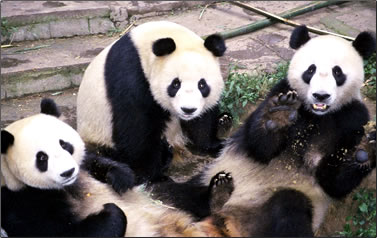
After years of debate, DNA testing has proved that the giant panda is a member of the bear family rather than the raccoon family. Lucy Corne

Next morning we were ready for work. After shaking hands with professional panda handlers, Mr Dong and Mr He, we were handed grey uniforms and a sweeping brush and pointed in the direction of something that there is no absence of in a panda sanctuary – poop. Each panda creates 15 to 20 kilograms (33 to 44 pounds) of it every day!
Each keeper cares for a specific group of pandas, with me assigned to help out with four adult pandas under the watchful eye of Mr He. I quickly found that each of the four had a distinct personality: Bei-Yang had a penchant for climbing trees and a much-appreciated tendency to poop out in the bushes far from the reach of my shovel; his larger counterpart Fu-Fu loved posing for tourists’ cameras; You-You was the sole female in our section and demanded the attention that any only daughter would expect; and lastly there was Zi-An, who instantly stole my heart. Rescued from the wild, Zi-An was the granddaddy of the reserve at 18 years old. Blind in one eye and missing part of one leg, he was a heart-wrenching sight. Yet he quickly became my preferred panda.
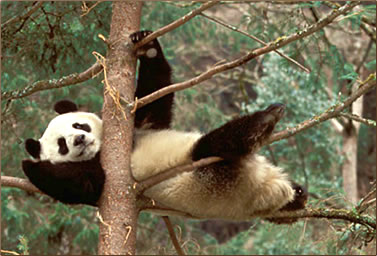
This magnificent animal, a survivor of the ice age and centuries beyond, remains in grave danger of extinction. Team Husar/Pandas International
We fell into a satisfying routine – after a huge breakfast of fried rice, congee or baozi (steamed buns) in the on-site restaurant, we ambled down to our work station, stopping to say good morning to another dozen pandas en route. There we changed into our comfy if somewhat ill-fitting uniforms. Like all of the female staff, my overalls had enough room for an extra person inside. Shawn on the other hand discovered that there was nothing to fit his 6ft-7inch frame and ended up showing a lot of ankle while he hauled bamboo or took lunch to the pandas.
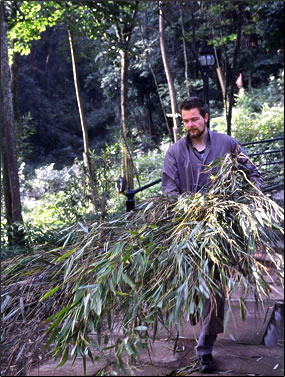
Shawn clears out yesterday’s Bamboo. Lucy Corne
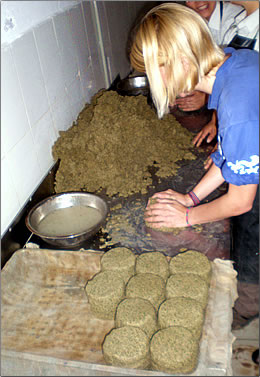
Lucy helps make panda cakes. Shawn Corne
Pandas are not cuddly toys and trying to clean up while they are within reach is a recipe for disaster. So each panda has to be enticed to a separate enclosure with their favourite food. Bei Yang would move mountains for a piece of panda cake (a mix of four types of flour, water and eggs, moulded and baked), You-You was a sucker for bamboo shoots, while the only thing Zi-An would shift his three-legged frame for was a handful of fresh carrots. The work was active but not too strenuous, with help always on hand if a task turned out to be tricky.
Once the enclosures were cleaned, we got to know the people behind the pandas. At first hesitant about his English, Mr Dong soon acted as our translator. We were grateful for his language abilities as our Mandarin had not yet extended beyond basic greetings and getting a beer. But during those mornings between the pandas’ frequent feeding times, we learned how to order food, how to read some Chinese characters and most importantly of all, Mr He taught us the ubiquitous game of Mah Jong.
When twins are born, mother pandas cannot usually care for both cubs. In the wild, the mother will select the stronger of the two, but in the sanctuary setting, every cub raised helps the species survive. At the Panda Reserves, the caretakers in the nursery leave one cub with the mother for her to care for and place one in the nursery in an incubator. In the nursery, the staff hand feed the cub and stay with it 24 hours a day.
After about a week, the cubs are “swapped” so both cubs will bond with their mother and receive her care. The mother accepts each baby, but only one at a time. This process of exchanging the cubs was developed at the Wolong Panda Center which now has a 90% survival rate with captive born cubs, due in large part to this method of raising twins.
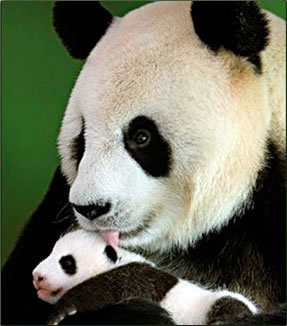
Photo credit: Team Husar/Pandas International. Information courtesy of Pandas International.

After a couple of days, our mentors realised we weren’t going to be silly enough to cuddle the pandas and they began to relax, allowing us a little more responsibility. We weighed out the five-a-day meals and were occasionally allowed to deliver the food unassisted. We were even invited to join in with the short “training” sessions that happened a few times a week. The training in question is essential for animals that have to be raised in captivity. The simple acts that each keeper teaches their pandas are designed to assist with any necessary medical treatment. We never tired of watching Jin-Zhu, one of Shawn’s pandas, practice her well-honed ‘open wide’ trick – devised to prepare her for dental checkups.
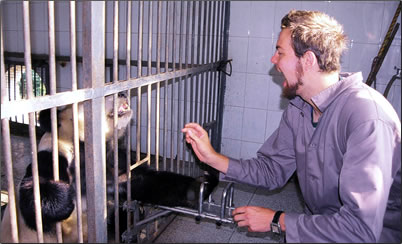
Shawn coaches Jin-Zhu to open his mouth on demand which helps with medical/dental check-ups. Lucy Corne
Because most volunteers only visit for a couple of days during a larger tour of China, our hosts worried that we’d get bored during 14 days of the same routine. But in truth when we bid farewell to our pandas and our new Chinese friends we were not ready to leave. We said a sad zai jian to our hosts, thanking them with a feast of fearsomely spicy but wonderful Sichuan food, washed down with the dozen beers required to douse the heat.
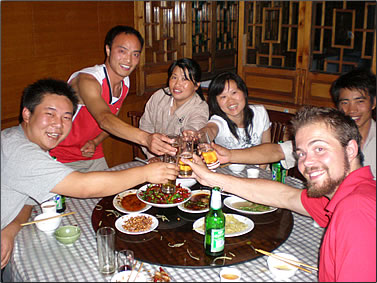
Staff and volunteers share a farewell dinner. Lucy Corne
Even tougher was saying goodbye to the animals I’d waited my whole life to meet. I shed a few tears as I gave Zi-An his carrots for the final time, but I told him that I’d be back some day and I know that I’ll keep that promise. Spending time at Bifengxia brought out my inner child again, and with it all of my childhood dreams were renewed.
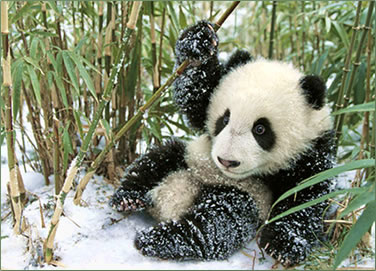
Photo credit: Team Husar/Pandas International.
 A study in 2004 by the Chinese Department of Forestry estimated the population of wild Giant Pandas at about 1,600. There are approximately 200 pandas in captivity. At birth, a panda cub weighs 4 to 8 ounces; a full grown adult is 165 to 350 pounds!
A study in 2004 by the Chinese Department of Forestry estimated the population of wild Giant Pandas at about 1,600. There are approximately 200 pandas in captivity. At birth, a panda cub weighs 4 to 8 ounces; a full grown adult is 165 to 350 pounds!
Volunteering stints at Bifengxia and other panda reserves can be organised through a number of local and international agencies. For reputable operators, visit Pandas International. Volunteer stays vary in length from a single night to several weeks; at least three to four days is recommended to get to know the pandas. Uniforms and gloves are provided – all you need is a camera, a love of animals and a willingness to get your hands dirty!
About 65% of volunteers visiting Bifengxia are over 45 years old. Rates vary depending on length of stay and whether your China guide stays with you or leaves you to it. Rates start from $50 per day, including meals and accommodation.
Based in the U.K. and South Africa, Lucy Corne is a freelance writer with incurable wanderlust and a passion for the offbeat. Her itchy feet have taken her to over 40 countries across every continent except Antarctica. As well as writing guidebooks for Lonely Planet, Dorling Kindersley and Bradt, her travel features have been published in the Toronto Star, Wanderlust and numerous in-flight magazines. www.lucycorne.com.
Feel free to explore other stories about volunteer vacations well suited to senior travelers, their families and friends. Click on the titles below to read each inspiring article.
Volunteer to teach English in Crete
Organic farm and garden volunteer travel
Volunteer for wildlife in Africa
Volunteer at India tea estate
Hawaiian Islands volunteer vacations
Cheetah volunteer vacations
Older travelers love volunteering
Volunteering in Rural Tanzania
Monitoring the health of Australia’s Great Barrier Reef
Earthwatch volunteers in Barbados
US Native volunteer vacations
Volunteer vacations worldwide
